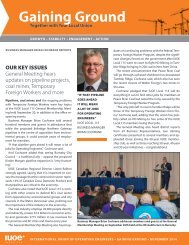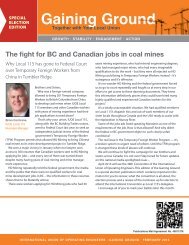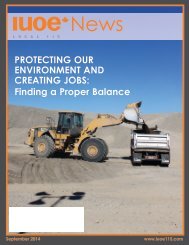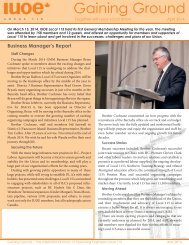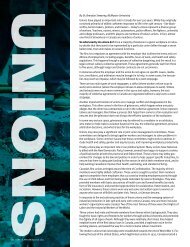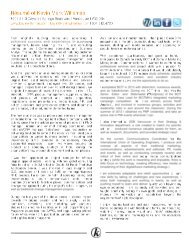OE News Special Edition July 2013
OE News Special Edition July 2013
OE News Special Edition July 2013
You also want an ePaper? Increase the reach of your titles
YUMPU automatically turns print PDFs into web optimized ePapers that Google loves.
The interest rate impact<br />
The following is an example of interest rate impacts. If I want to pay you a certain amount of<br />
money now, in return for your promise to pay me $1 per year indefinitely, the amount I’ll have<br />
to pay depends on current interest rates. If rates are high, I’ll be able to pay you less, because<br />
you’ll have the opportunity to invest the money I pay you at a high rate of return.<br />
In other words, I need fewer assets now to secure certain future payments when interest<br />
rates are high. And I need more assets when interest rates are low.<br />
A pension plan works the same way. The plan has assets now and needs to make certain<br />
payments in the future. The current value of a pension plan’s future liabilities (and therefore<br />
the assets it needs now to meet those liabilities) goes down as interest rates rise, and goes up as<br />
interest rates drop.<br />
In other words, a pension plan needs fewer assets to make the same future payments<br />
when interest rates are high than when interest rates are low.<br />
This has been a growing problem in recent years as interest rates have steadily declined,<br />
resulting in an increasing level of liability for the <strong>OE</strong>PP and other pension plans. By shifting to<br />
a different mix of assets, the Trustees believe we can protect our plan against the impact of low<br />
interest rates, and of interest rate changes generally.<br />
The Plan’s asset mix<br />
The large majority of our assets continue to be made up of bonds. A bond is simply a promise<br />
to re-pay a certain amount of money at a specified date, with interest payments in the interim<br />
based on a fixed rate. It is a “fixed-income asset”, meaning that there is no doubt as to the rate<br />
of return it will deliver. The only risk relates to the survival of the bond issuer. Although this<br />
can be an issue with corporate bonds, it is much less of an issue with government bonds. The<br />
pie charts below show all of the Operating Engineers’ Pension Plan assets by class and what<br />
each manager holds<br />
By asset class<br />
0.4 % Real Estate –<br />
Mortgages (internal)<br />
2.5 % UBS Global<br />
Asset Management<br />
0.8 % Fengate<br />
Capital Management<br />
4.6 %<br />
Mortgage Fund Two<br />
0.3% Realcor Mortgage<br />
Fund (external)<br />
Real Estate<br />
– Revenue<br />
Producing<br />
20.6%<br />
PHN – Bonds<br />
60.4%<br />
0.2 % Real Estate –<br />
Non-Revenue Producing<br />
5.6% Prepaid Leases<br />
3.3% Concert Properties<br />
1.3% Short-term<br />
Interest Rates and<br />
Promises to Pay<br />
Cost of a promise of a<br />
$1/year indefinitely, at<br />
different rates<br />
Cost Interest Rate<br />
$10.00 10%<br />
$16.67 6%<br />
$20.00 5%<br />
$25.00 4%<br />
$33.33 3%<br />
$50.00 2%<br />
Interest Rates<br />
and Pension<br />
Plan Liabilities<br />
As<br />
interest<br />
rates<br />
drop....<br />
... the<br />
value of<br />
pension<br />
plan<br />
liabilities<br />
rises.<br />
<strong>Special</strong> <strong>Edition</strong> Summer <strong>2013</strong> <strong>News</strong> 7








